Menu
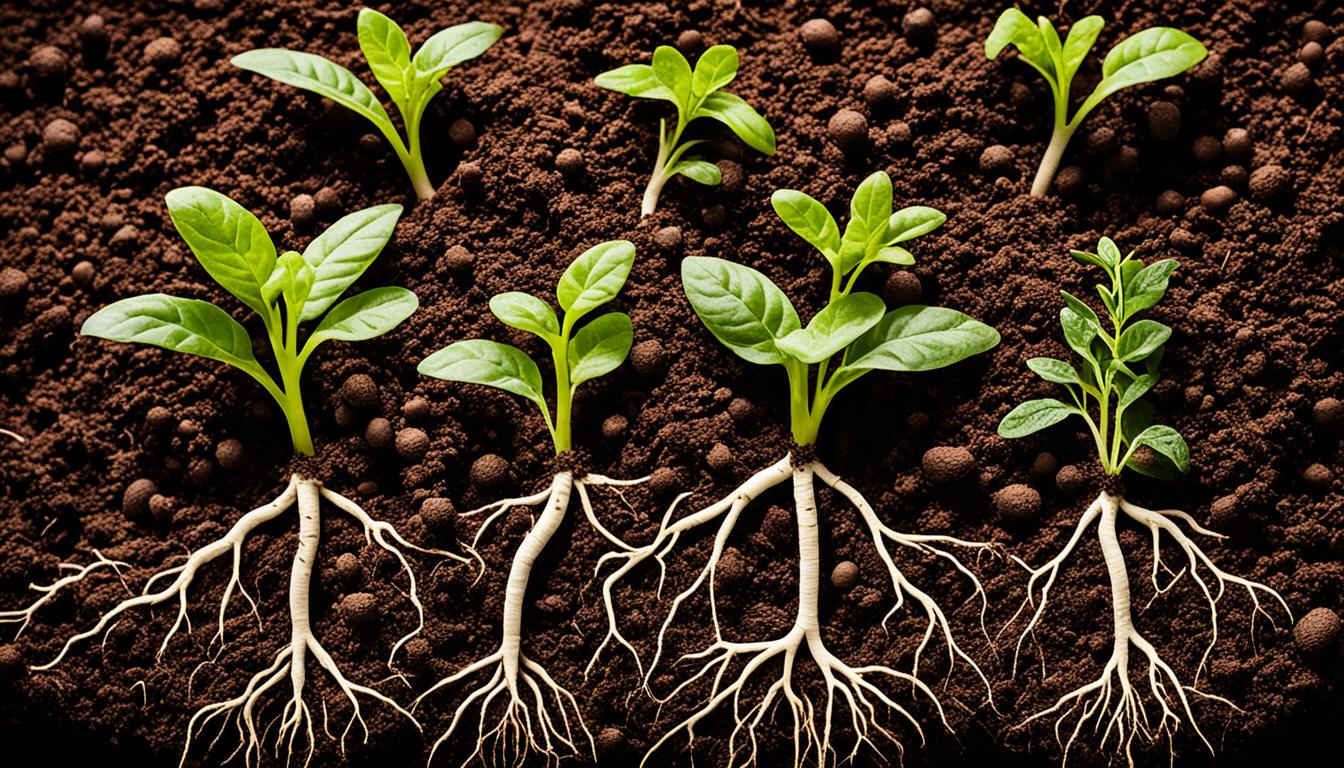
Did you know a recent study looked at crop yields over 18 years on ten corn and soybean farms in Michigan, Illinois, and Indiana? The study found certain areas where yields were always good. This is huge news for soil health and keeping agriculture sustainable. The research could change how we think about soil quality. This is key for making sure there’s enough food worldwide.
Funding from the U.S. Department of Agriculture and the USDA’s Natural Resources Conservation Service made this research possible. It marked a big step forward. The study focused on places with very good or poor crop yields. By doing so, it highlighted how healthier soil improves farming, though this kind of study can be really expensive.
Working with dairy and crop farms, the team picked 68 soil samples in Fall 2023. They looked at soil fertility, its texture, and the amounts of carbon and nitrogen. They also checked for how many helpful microorganisms were in the soil. These soil tests help figure out the best ways to manage soil. This can make the soil hold onto water better and be more fertile. Ultimately, it can help make more food worldwide.
Soil health research plays a big role in keeping our farms sustainable and profitable. It sits at the intersection of looking after the earth while growing food. By managing soil fertility well and using sustainable farming, we help our fields prosper. This benefits the environment too.
Soil health is deeply tied to partnerships between different fields, says Brevik EC et al. (2015). AgSource links farm data to what really works in the field. It shows that healthy soil leads to better protection of the earth and more food. This is crucial for farming that lasts for the long haul.
Michigan State University looks at past crop yields to improve farming. They focus on areas that always do well, soil carbon, and soil health. This shows how crucial good farming methods and healthy soil are for growing food. It’s a key part of talking about how to care for the soil for our future.
Now, with threats from industry and changing farming, the world is waking up to soil health, says Zimnicki T et al. (2020). Agropages notes that soil isn’t just ground; it’s vital for nature and farming. As a result, there’s a growing interest in soil health tech. Experts like Pittelkow CM et al. (2015) push for farming that both saves the earth and boosts food production. The Soil Health Institute looks into special projects to make soil work better.
| Statistic | Impact |
|---|---|
| Development Pressure | Nearly 11 million acres of land lost between 2001 and 2016, with 2000 acres per day being covered in pavement. |
| Soil Function Loss | Indicators include decreased crop yields, increased hunger, reduced organic matter, and higher erosion rates. |
| Soil Aggradation Climb | Improvements noted in organic matter turnover, nutrient cycling, and water availability. |
| Farmers’ Vision | Farmers in various locations like Helena, AR, and Lafayette, LA are embracing management practices to boost soil functions. |
It’s vital to know the main physical bits of soil health. This helps keep it in good shape and productive. The way soil feels affects plant growth, water management, and its strength.
Soil texture talks about the size of soil particles. It affects how the soil is put together and its health. Soils with big particles can’t hold water well. This makes it hard for plants to get enough water to grow.
Using methods like planting cover crops and not tilling as much helps. They can make the soil keep water better. This boosts how much food we can grow.
How well soil holds water is linked to its structure. The way particles come together affects air space and water movement in the soil. This is key for plants to get the water they need.
Adding organic stuff to the soil or using certain methods can help. They make the soil better at keeping water. Just a 1% rise in organic matter can increase water storage by 20,000 gallons per acre. That’s a big win for farming that lasts.
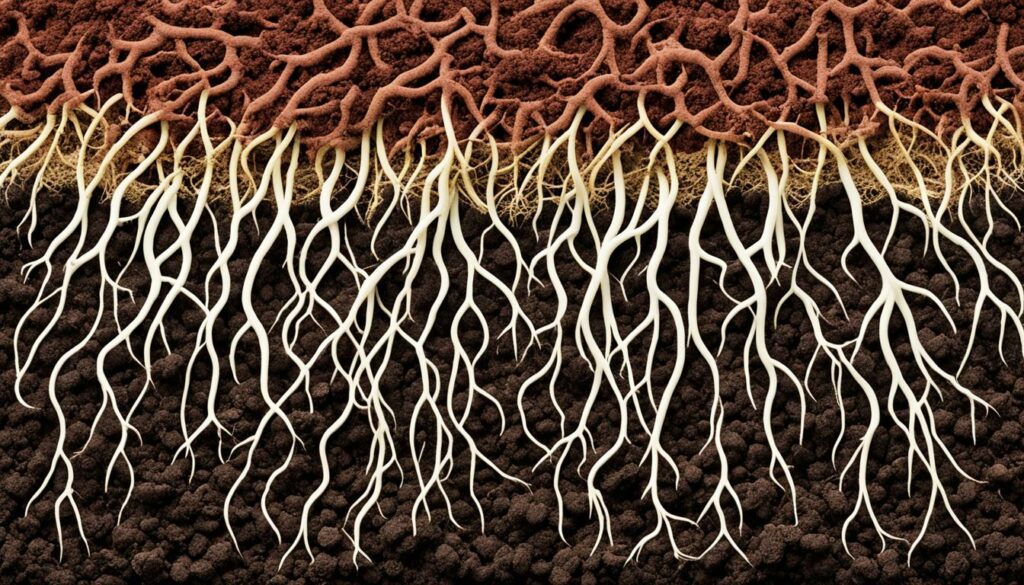
If we manage soil well, farm yield stays steady, even in tough spots. Places with more organic stuff in their soil do better. By using a variety of techniques, we can make the soil’s structure and water storage work well. This makes farming more dependable and fruitful.
Soil chemical fertility is crucial for plants to grow well and for farming to last. It helps us know how plants can get the nutrients they need from the soil.
Testing the soil for nutrients is key to keeping it healthy. Farmers need to know what nutrients are there and how much. Then, they can add what’s needed for their plants to grow strong. Research shows that having the right nutrients leads to good crop yields and sustainable farming.
There’s a big difference between nutrients that dissolve in water and those that need help from microbes to be useful. Experts say recognising this helps manage nutrients better. It ensures plants always have what they need to grow.
| Nutrient Cycle | Water-Soluble | Combustible |
|---|---|---|
| Nitrogen | Nitrate (NO3-) | Organic N compounds |
| Phosphorus | Phosphate (PO4^3-) | Organic P compounds |
| Potassium | Potassium ions (K+) | Organic K compounds |
| Calcium | Calcium ions (Ca+2) | Organic Ca compounds |
By knowing soil fertility well, and with regular tests, we can keep nutrients going. This makes the land stay productive for growing food.
We need to understand how soil microbes and soil health connect for farming that lasts. Microbes in the soil work hard to change dead plants and animals into food for new plants. The levels of carbon and nitrogen tell us how well these microbes are working.
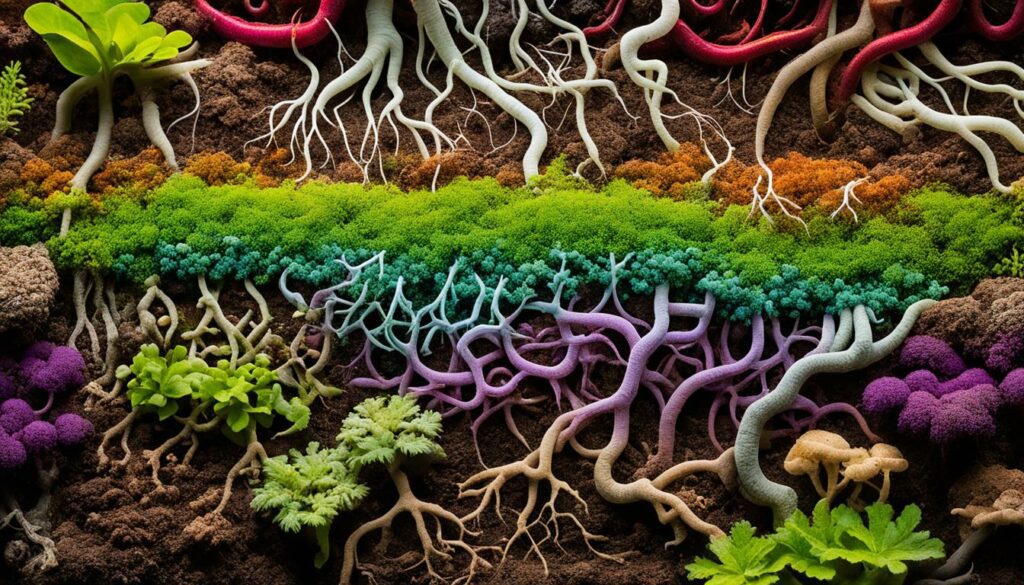
The right amount of carbon and nitrogen is crucial for healthy soil. Farming with legumes can stop these important elements from escaping the soil. This helps microbes thrive, leading to better soil for storing carbon. Reduced carbon escape benefits the UK too, reminding us of the importance of sustainable farming. We must also think about how genetically modified plants can affect soil life and metal levels.
Measuring CO2 released by soil is a smart way to see if the microbes are doing well. This rate directly shows how busy the microorganisms are and if the soil is healthy. High CO2 takes nutrients from the soil due to plant growth. Forests also show us that soil breathing affects how much they can grow. So, keeping the soil’s tiny life thriving is key to the planet’s health.
Soil health, CO2 levels, and the balance of elements are all linked. Knowing these ties helps us farm better, supporting a healthier environment.
Using the right soil conservation methods is key to good farming. It helps keep the land healthy for the future. By stopping erosion and capturing carbon, we do the earth a big favour. Also, it makes our crops better and the soil stronger.
Reduced tillage is a big player in saving soil. It’s also called no-till farming. This approach saves soil by keeping moisture in. It does this by not disturbing the ground too much. That way, the soil stays rich in good stuff like plants and tiny creatures. It’s found that leaving a lot of crop leftovers on the land really helps stop soil going away. Farming this way is good for the planet and for the farmer’s pocket.
Farmers all over are starting to use cover crops more. This is good for the soil and the atmosphere. Cover crops, like certain plants, naturally feed the soil. They put back what plants take out, making soil healthy again. They also slow down wind and water. This makes it harder for soil to wash away. All this helps keep the land steady and healthy.
| Technique | Benefits |
|---|---|
| Reduced Tillage |
|
| Cover Crop Integration |
|
Mainstreaming sustainable agriculture is key for the planet. Regenerative farming boosts soil quality for the long haul. It creates a win-win for both farming and the environment.
Getting the right mix of crop growing and soil care is vital. Techniques like not tilling and using cover crops help a lot. They stop soil from washing away, improve how it breathes, and keep water where it’s needed.
Planting without tilling cuts down on bad gases and welcomes useful critters. It also keeps the plant food (nitrogen) in the ground well, which synthetic stuff can’t do as well. Windbreaks help stop soil blowing away, too.
Looking after organic matter well is heart of farming right. Things like rolling over crops without digging them up can really help. This keeps most of the good stuff in the soil for plants.
Mixing it up with different plants can do wonders for the health of a field. It stops soil from running off, cuts down on bad weeds, and keeps nutrient-rich soil. Doing this every so often with your crops really helps keep the ground in great shape.
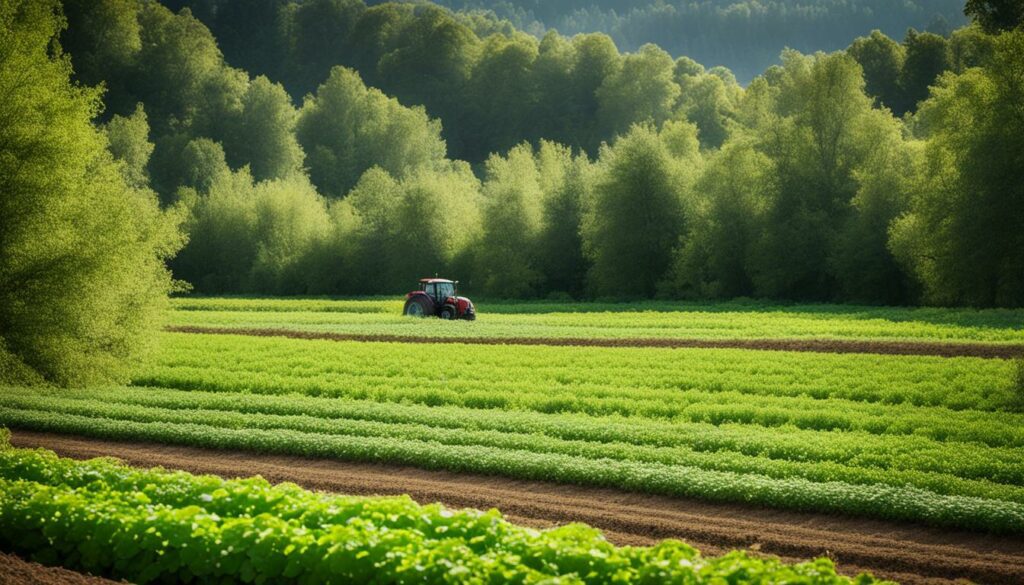
With the world needing more food soon, smart farming is a must. Focusing on soil health and stopping soil wash can help us feed everyone. Embracing new ideas in farming and watching the life in our soil can make a huge difference for us all.
Soil nutrient testing is key in managing soil fertility. It gives details on soil nutrients. This helps apply the right amount of fertiliser. This targeted approach lifts crop yields by 20%, especially with no-till methods.
It also helps environmental health. Testing soil quality keeps nutrients in check and cuts water pollution by 40%. It makes sure nutrients are used efficiently, lowering pollution from farming into water.
Testing soil nutrients backs farming and saves money. Farmers making smart fertiliser choices earn more. Although basic testing costs $5 to $15, the extra profit covers this easily.
| Benefit | Impact |
|---|---|
| Increase in Crop Productivity | 20% |
| Reduction in Water Pollution | Up to 40% |
| Contribution to Nutritional Quality and Productivity | 60% |
| Reduction in Soil-borne Diseases | 30% |
| Soil Organic Matter Increase | 0.1% annually |
Monitoring nutrient cycling does more than help farms right away. It boosts long-term farming by preventing soil damage and nutrient problems. Over 1.5 billion people suffer from bad soil care. Good soil testing can fix this and secure the future of farming for our children.
Studying soil health is key to improving farming’s economic and environmental impact. Let’s explore two major studies in this area: AgSource’s 2023 Fall Project and a study from Michigan State University on crop yield history. These show us how soil health practices can lead to better outcomes.
The 2023 Fall Project by AgSource has shown a clear link between good soil practices and making more money. Farmers who changed their practices made a lot more money:
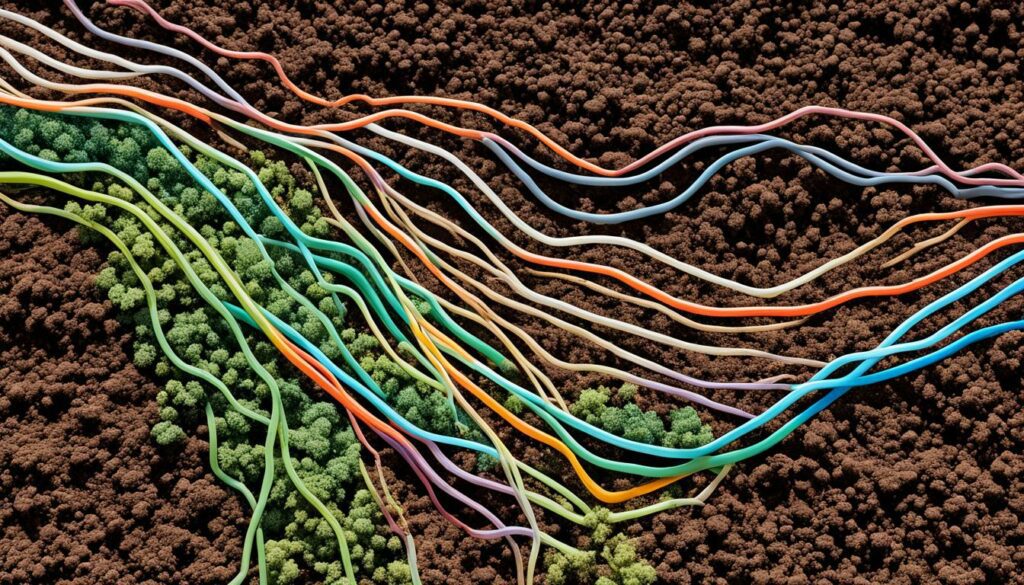
| Farmer | Location | Practices | Increase per Acre | Total Increase |
|---|---|---|---|---|
| Ralf Sauter | California | Various soil health practices | $657 | $76,155 |
| Tom and Dan Rogers | California | Specific soil health practices | $991 | $173,345 |
| Christine Gemperle | California | Cover crops | $499 | $9,976 |
| John and Jim Macauley | Illinois | No-till practices, cover crops | $44 | $25,036 |
The AgSource study proves that improving soil can lead to more money. Even small changes in farming can bring great gains.
Michigan State has done groundbreaking work connecting soil health to good crop growth. This info is vital for making farming methods better and smarter:
Both AgSource and Michigan State’s studies are important. They help farmers make more money and take better care of the land. These efforts lead to smarter, more effective farming for everyone.
In recent years, big steps have been taken in making soil healthier. This has changed how we do farming in a better, more sustainable way. New farming tools and soil tests are being used. They make farming more efficient and better for the environment by pinpointing what’s needed and where.
Precision farming is a big leap in modern farming. Farmers use high-tech tools to use fewer resources but more effectively. For example, equipment with GPS can create maps of soils, showing where different actions are needed.
Research, like Karlen DL’s work in 2019, shows these tools help a lot. They collect detailed soil information, helping farmers to make better choices. This can lead to saving the soil and producing more crops.
The soil testing equipment market is improving fast, offering more accurate, up-to-date data. Improved sensors and data analysis let us understand soil health more clearly. They check pH levels, nutrients, and such. These findings help close the gaps in knowledge about farm water pollution discussed by Evans AE et al. in 2019.
With these tools, farmers can do farming in ways that are kinder to nature. Norris CE and Congreves KA’s 2018 study backs this up. It says using new testing tools can really boost soil health, especially in places where crops are grown a lot.
Carbon sequestration in soil is crucial for fighting climate change. Agriculture has released over 133 billion metric tons of CO2 in the past 12,000 years. This is more than three times 2019’s total human emissions. By using methods like reduced tillage and cover crops, we can reverse this. These practices help the soil capture and store more carbon.
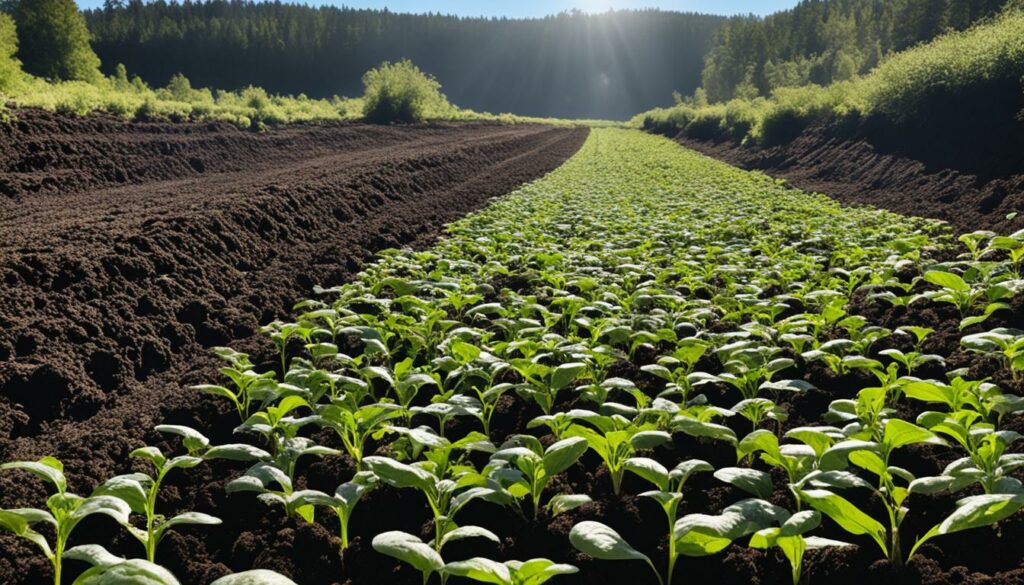
The amount of carbon dioxide in our air has risen by 45% since the Industrial Age. We really need to act. Soils can be powerful in pulling carbon out of the air, potentially cutting down 5.3 billion tonnes of CO2 yearly. But, soil has lost a lot of its natural carbon, up to 70%. We must focus on restoring soil health. Right now, about a quarter of emissions get soaked up by forests, fields, and grasslands. This shows how important these areas are for fighting climate change.
Farmers can use many methods to make their farming better for the climate. These include:
The Growing Climate Solutions Act helps farmers join in voluntary carbon markets. In these markets, a metric ton of carbon might sell for $15–$20. The USDA is supporting this by expanding programs like the Conservation Reserve Program (CRP). These moves, along with new farming methods, are leading towards a greener future in agriculture.
Basso’s research shows that healthy soils are good for both farming and fighting climate change. It points out how important soil carbon sequestration is.
Soil health is key for farming that lasts without harming the environment. But, it’s in danger from many sources. Soil is facing big threats like pollution and loss of plant and animal varieties. These problems challenge how we will grow food in the future.
The fast growth of cities and industries is hurting our soil. Big efforts are ongoing to keep soil healthy, like in the U.S. However, climate change is making soil loss and water pollution worse. This harms the soil even more. Projects and people are working hard to help. But, things like using too many chemicals in farming are still a big issue we need to fix.
In farming, we see less and less variety as areas are growing one crop or using too many chemicals. This hurts the balance of nature, making crops more likely to get sick. Practices that keep soil and water clean are helping fight this. Leaders like Dr. LaKisha Odom and Jocelyn Hittle show how healthier soil and water make farming better.
| Challenges | Impact on Soil Health | Counter Measures |
|---|---|---|
| Soil Degradation | Loss of soil structure, nutrient depletion | Grants, conservation practices |
| Pollution | Contamination of soil and water resources | Adoption of organic farming techniques |
| Decreased Biodiversity | Weakened ecosystem resilience | Promotion of polyculture farming |
Looking at the big picture, FFAR has put over $30 million in helping soil health. This is a big step forward. But, there is still so much to do, especially with the challenge of climate change. This affects how we farm and protect the environment.
Policy backing for soil health is essential for farming and looking after the earth. For example, the United States Farm Bill support and the European Union’s Soil Strategy set the stage for dealing with soil health. Thanks to these efforts, managing soil health is becoming a major focus.
The Farm Bill is key in making soil health better across the US. Groups like Land Core work with the USDA and lawmakers. They aim to make laws that help soil stay healthy. Now, 26 states have laws supporting soil health, showing the country’s dedication to keeping farms green. Also, 27 states, such as Pennsylvania, take care of over half the farm areas in the US well.
The Farm Bill does a lot to help. It gives money to farmers who use good farming methods. It also offers help in dealing with issues that affect soil health. All the work together means soil health projects can grow in the US.
In Europe, the European Union’s Soil Strategy is working towards big aims for the soil. By 2030, they want all the soil in Europe to be healthy. They will start this with a new law in 2023. The goal is to get everyone in Europe working together to keep the soil well. They aim to have 100 special places for testing and learning by 2030.
This effort in Europe teams up with work in Australia and other places too. For example, Australia has a strategy that looks 20 years ahead. These plans are a good model for the world to follow. They show how to make sure the land we farm stays healthy.
| Region | Strategy | Key Actions | Timeline |
|---|---|---|---|
| United States | Farm Bill | Healthy Soils legislation, collaboration with USDA | Ongoing |
| European Union | Soil Strategy | Soil Health Law, Soil Manifesto | 2030 |
| Australia | National Soil Strategy | 20-year roadmap, National Soil Action Plan | 2041 |
| United Kingdom | Soil Health Inquiry | Sustainable soil management | 2030 |
The soil health industry is very important. It balances good farming methods with new tech. This brings big benefits to farmers and the global economy.
Using better soil health techniques is making a big difference. It raised farm incomes by about $65 per acre on 29 farms. It also cut costs for growing key crops. For corn, costs were $14 less an acre. For soybeans, it was $7 less per acre. Other crops cost $16 less to grow. With these techniques, more crops are being grown well, too.
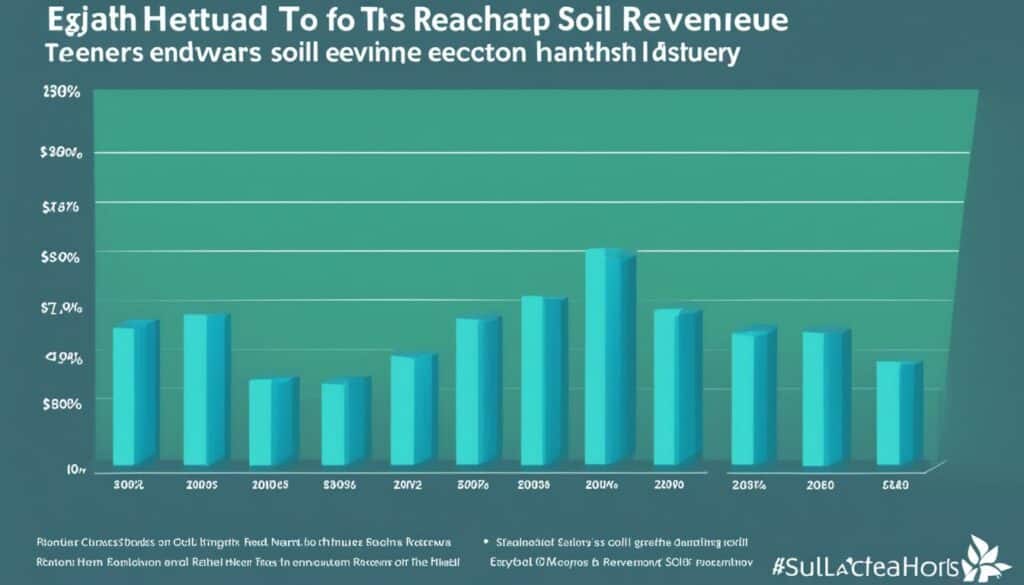
There’s a growing interest in good soil practices like no-till and planting cover crops. In fact, about a third of all fields are using no-till. And, cover crops are now on over 8% of farms not left fallow. A plan like EQIP helped cover crops a lot. They launched from $5 million to $50 million in support. This program has now helped twice as many fields to plant cover crops.
A lot of money can be made by investing in good soil health. With more people choosing eco-friendly ways, soil health businesses are growing. This means it’s a good time to invest in tools and methods that keep soil healthy. These methods often cut erosion, lessen soil pressing down, and toughen up crops against bad weather. All these make investing in soil health a smart move.
In some parts of the US, more farms are using no-till and cover crops. They have it high for soybeans, planting them without digging up the soil. This shows there’s a chance for investors to do well in those areas. Plus, programs that give a hand in caring for the land, like CSP, help these opportunities grow.
Making soil health a big deal can really boost the economy. More than half of farmers using these methods say they are getting better yields. They’re making more money per acre, too. So, there’s a lot of promise for growth in this industry.
The journey through soil health research shows us its huge impacts. It includes how soil management and eco-friendly farming help our nature and food. Many studies have looked at the benefits of soil. They show that healthy soil supports strong plants and many different species.
No-till farming and adding natural materials to the soil have big benefits. They help keep carbon in the ground and boost food growth. Built wetlands can also clean water by tackling harmful chemicals like nitrates and pesticides in the soil. This is good for the environment.
The tiny organisms in the soil, like bacteria and fungi, are very important for plant health. Recent research has found that they can also help prevent plant diseases. This highlights the key role of these micro-organisms in maintaining our crops.
As we look ahead, we see more ways to test and understand soil. These advancements in soil health checks will help farmers know their soil better. This will lead to actions that improve soil health. Global efforts are needed to protect our soil by supporting better policies and new technologies. Everyone from scientists to farmers to leaders must work together. Their combined work is vital for the future of our planet’s agriculture and food security.
Healthy soil is key for farms to be fruitful and eco-friendly. It helps crops grow better, protects nature, and keeps ecosystems alive. Looking after soil fertility and the types of life in it is a big part of farming well.
Soil texture is how much sand, silt, and clay there is. It affects how well soil holds water and nutrients. Some soils struggle to keep water but using certain plants and not digging a lot can help.
Soil microorganisms are key for moving nutrients and keeping soil rich. The right balance of these tiny lives shows if the soil is really healthy. They help make sure the soil is full of life.
Not digging a lot keeps the structure and nutrients in the soil. It stops soil from washing away and helps it keep water. Doing this helps farming last longer and be good for nature.
Testing soil tells farmers what the soil needs to feed the plants well. This helps them use the right amount of fertilisers and be kind to nature. Good testing makes sure crops grow better without harming the Earth.
New technology has made taking care of soil easier and smarter. Tools for farming and checking soil tell us more than ever about what the land needs. This helps farmers do their job in ways that keep the planet healthy.
Keeping carbon in the soil stops it from warming our planet. Modern farming methods can lock away more carbon. This makes the land not just good at growing food but also a hero in fighting climate change.
Making the land into cities and factories can hurt soil. It makes soil dirty, can make life in it die, and makes farming harder. We need strong plans to keep the soil clean and able to grow food.
Laws that help the soil are very important. In the US, the Farm Bill does this, and in Europe, the Soil Strategy does. This gives a plan and money to keep farming and nature going strong together.
The need to care for the soil is making a big business opportunity. As people want to farm and make things without hurting nature, new ways and tools are needed. Investing in these helps not just the farms but also the planet.